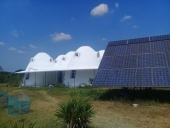I like to use a battery powered plaster mixer to mix the lime and fiber into the
water before adding the sand. This makes sure the lime mixes all the way without leaving lumps. I use cut off 55 galon plastic drums for mixing as they are cheap and tough. I use cellulose insulation as fiber because it is cheap, has fine fiber size and requires less prep than other options. A mix I like to use for finishing consists of
1 bag of hydrated lime, 5 gallons of sand and 2 gallons of fiber. I use this as the final coat and whitewash it after.





